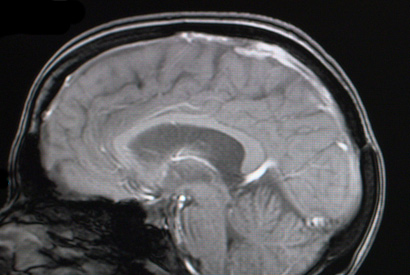Campus poised to join Obama’s BRAIN initiative
President Barack Obama has announced a major national initiative to understand how the brain works and how it goes awry. Neuroscientist John Ngai, chemist Paul Alivisatos and chemical engineer Jay Keasling were on hand at the White House to lend support to the so-called BRAIN initiative, which Ngai termed "our moon project."

April 2, 2013
Three UC Berkeley scientists were among a gathering of the nation’s top scientists at the White House this morning (Tuesday, April 2) as President Barack Obama announced a major national initiative to develop new tools to create real-time traffic maps of the human brain.
In a White House briefing, Obama proposed an initial $100 million investment this year in the Brain Research through Advancing Innovative Neurotechnologies (BRAIN) initiative, which “ultimately aims to help researchers find new ways to treat, cure, and even prevent brain disorders, such as Alzheimer’s disease, epilepsy, and traumatic brain injury,” according to a White House press release.
“There is this enormous mystery waiting to be unlocked, and the BRAIN Initiative will change that by giving scientists the tools they need to get a dynamic picture of the brain in action and better understand how we think and how we learn and how we remember,” Obama said. “That knowledge could be — will be – transformative.”
John Ngai, director of UC Berkeley’s Helen Wills Neuroscience Institute and professor of molecular and cell biology, Paul Alivisatos, director of Lawrence Berkeley National Laboratory and professor of chemistry; and Jay Keasling, associate director for biosciences at Lawrence Berkeley National Laboratory, CEO of the Joint BioEnergy Institute and professor of chemical engineering, were invited to the White House to support Obama’s initiative, which was proposed last year in a paper coauthored by Alivisatos and five brain scientists.
“This is our moon shot,” said Ngai. “The president is giving U.S. scientists the support and resources to develop the tools we can use to really start to understand how the brain works. This is a lasting legacy that will be felt for generations.”
In a video accompanying the press release, National Institutes of Health (NIH) director Francis Collins said that BRAIN will “bring together nanoscience, engineering and neurology to make sense of how the brain works, how those circuits in the brain allow us to do all those complicated things that we currently don’t understand. … Out of this is going to come a foundation for understanding the brain that we have dreamed about all through human history.”
Obama assembles “dream team”
NIH, the National Science Foundation and the Defense Advanced Research Projects Agency, along with private foundations such as the Kavli Foundation and Howard Hughes Medical Institute, will partner to support the research, which will be guided by a “dream team” of scientists led by Dr. Cornelia “Cori” Bargmann of The Rockefeller University and Dr. William Newsome of Stanford University.
“The Brain Activity Map is a very promising project for developing revolutionary new tools to advance neuroscience and to enable improved understanding of neurological diseases,” Alivisatos said.” It is exciting that the nation will lean forward to make progress in this important area.”
The BRAIN initiative aims to not only map the brain’s 10 billion neurons and 100 trillion connections, but understand how signals travel along these circuits and what modulates those signals, Ngai said.
Ngai and others on campus and at the Lawrence Berkeley National Laboratory have been meeting in recent months, in part with the assistance of the Kavli Foundation, to identify the tools needed and how Berkeley scientists can contribute. The foundation has hosted various meetings around the country to gather input to help shape a national research initiative.
“We want to produce a roadmap with all the traffic patterns,” Ngai said. “The brain is a beautiful, efficient biological computer, and we want to understand how that computer works, how it learns and adapts, and how it goes awry. If we can understand the biology that underlies thinking and emotion, perhaps one day we can understand the basis of human consciousness.”
The project will involve not only neuroscientists like Ngai and chemists like Alivisatos and Keasling, but also computer scientists, physicists and engineers to develop tools and techniques that scientists don’t have today, such as the ability to record the electrical activity of thousands or even a million brain cells simultaneously, image the second-by-second flow of chemicals into and out of neurons, or capture in real time the waves of activity that allow communication between distant areas of the brain.
What scientists learn may also help design the next generation of computers. Faster and more efficient computers are needed to keep pace with the massive increase in data that’s being generated, and computer scientists are looking to the brain for inspiration, Ngai said.
RELATED INFORMATION
- President Obama’s remarks on BRAIN initiative (video)
- Transcript of President Obama’s remarks
- Fact sheet on BRAIN initiative